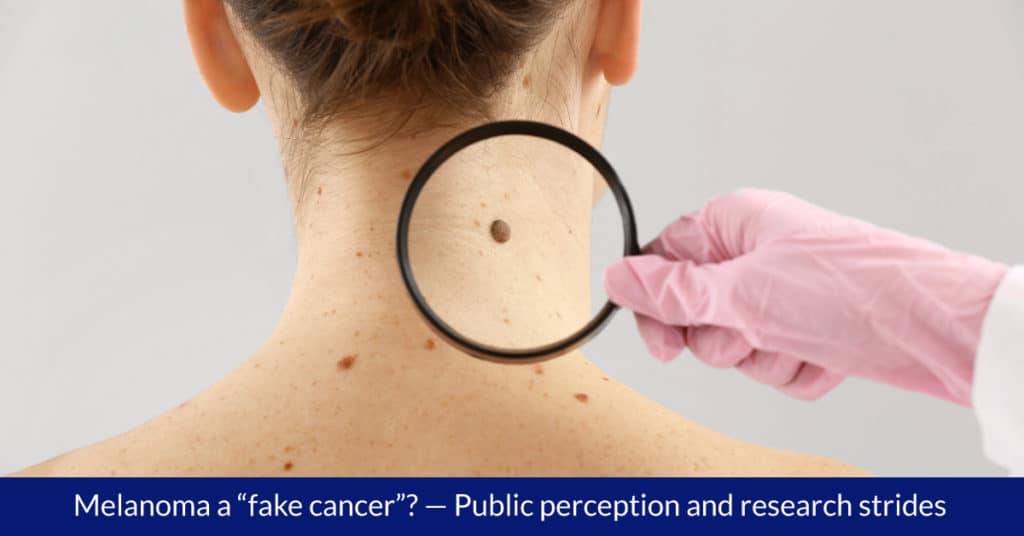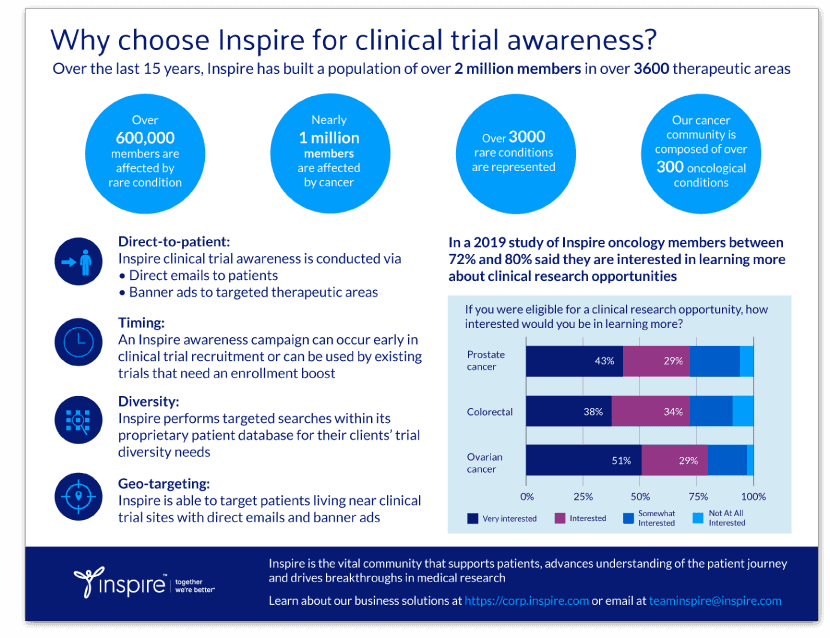Melanoma a “fake cancer”? — Public perception and research strides

By Kathleen Hoffman, PhD, MSPH
In a discussion of melanoma on Inspire, a caregiver said to fellow members:
The doctors and drug companies are making tremendous strides in the treatment of this terrible disease!!
Her message of hope resonates strongly today.
Unfortunately, misconceptions about this cancer linger among the general population. One newly diagnosed patient on Inspire described their confusion:
I was recently diagnosed with stage 3C…I honestly always thought melanoma was “fake” cancer, because you just cut it off, right? The fact that people didn’t associate it with chemo or poor prognosis just made it seem like no big deal. I’m embarrassed to tell people because it’s “just skin cancer” and I’m afraid they’ll think I’m being ridiculous. Is this serious? I’m not even sure what to think or feel.
There is nothing “fake” about melanoma. First written about by Hippocrates in the fifth century BC, melanoma remains a deadly cancer, diagnosed in an estimated 100,000 people in the US each year, with as many as 7000 deaths.1,2
My daughter was diagnosed with melanoma in [date] which was very small and was removed. It was stage 1 and the borders were clean- she was told that there was a 95% chance that she would never see it again. 4 years later in [date] she discovered that the melanoma had returned and was in her lymph nodes. It was now stage 3, by [date ] it [became] stage 4 with subcutaneous tumors and 2 small spots in her brain.
The observation made by surgeon Samuel Cooper that “the only chance for benefit depends upon the early removal of the disease…” has continued to be largely true since 1840.1 When caught early and when the melanoma is less than 1 millimeter thick, the 5-year survival rate is 93 percent. With increased thickness and involvement of lymph nodes, those numbers begin to fall. Lymph node involvement reduces the 5-year survival rate to 66 percent. Distant metastases reduce that rate to 27 percent.3
Chemotherapy is less effective in melanoma than in other cancers. In fact, those with advanced cancer treated with surgery and chemotherapy had only a 6 to 9 months survival rate, with just 25 percent living to one year.4 But in 2011, with the approval of targeted treatment, an enormous change occurred. With FDA approval of 10 new targeted and immunotherapeutic treatments since then, the mortality rate has fallen by one third. Today, over 2000 active clinical trials are testing targets.4
Some of these promising targets include IDO inhibitor, TLR9 agonist, STING, LAG-3, TIM-3, HDAC inhibitors, pegylated IL-2 (NKTR-214), GITR, and adenosine pathway inhibitors.4 Additionally, cancer vaccines and use of adoptive cell therapy show much progress.5 As only around half of those with advanced melanoma are five year survivors, research is currently focused on addressing primary and acquired resistance. Neoadjuvant therapy is also being discussed and tested as a treatment alternative.6
A recent approval in treatment may help increase survival rates. Based on the results of the KEYNOTE-716 clinical trial (NCT03553836), in December 2021, the FDA approved the use of pembrolizumab to prevent recurrence in patients diagnosed with 2B, 2C and 3 tumors.7
Education about melanoma specifically continues to be a challenge. Projections suggest the incidence of melanoma will peak in the next four years.8 With less than 40 percent of people in the US practicing sun protective behaviors such as application of SPF 30 or higher sunscreen, this figure may be optimistic.9 Research that extends the lives of those diagnosed with melanoma has made great strides, but prevention and education about the dangers of this deadly cancer must continue.
Inspire offers a trusted community to patients and caregivers. Our goal with this blog, this website and our content is to provide the life science industry access to the true, authentic patient voice. In so doing, we support faithful operationalization of patient-centricity. Take a look at our case studies, eBooks and news outlet coverage.
References:
1 Rebecca, V. W., Sondak, V. K., & Smalley, K. S. (2012). A brief history of melanoma: from mummies to mutations. Melanoma research, 22(2), 114–122. https://doi.org/10.1097/CMR.0b013e328351fa4d
2 https://www.cancer.org/cancer/melanoma-skin-cancer/about/key-statistics.html
3 https://www.cancer.net/cancer-types/melanoma/statistics
4Trojaniello C, Luke J, Ascierto. Therapeutic Advancements Across Clinical Stages in Melanoma, With a Focus on Targeted Immunotherapy. Frontiers in Oncology. 2021. 11.
DOI: 10.3389/fonc.2021.670726
5 https://www.cancerresearch.org/en-us/immunotherapy/cancer-types/melanoma
6 Menzies, A.M., Amaria, R.N., Rozeman, E.A. et al. Pathological response and survival with neoadjuvant therapy in melanoma: a pooled analysis from the International Neoadjuvant Melanoma Consortium (INMC). Nat Med 27, 301–309 (2021). https://doi.org/10.1038/s41591-020-01188-3
7 https://www.fda.gov/drugs/resources-information-approved-drugs/fda-approves-pembrolizumab-adjuvant-treatment-stage-iib-or-iic-melanoma
8 Whiteman D, Green A, Olsen C. The growing burden of invasive melanoma: projections of incidence rates and numbers of new cases in six susceptible populations to 2031. Journal of Investigative Dermatology. 2016. DOI: 10.1016/j.jid.2016.01.035
9 Saginala K, Barsouk A, Aluru JS, Rawla P, Barsouk A. Epidemiology of Melanoma. Med Sci (Basel). 2021 Oct 20;9(4):63. doi: 10.3390/medsci9040063. PMID: 34698235; PMCID: PMC8544364.






